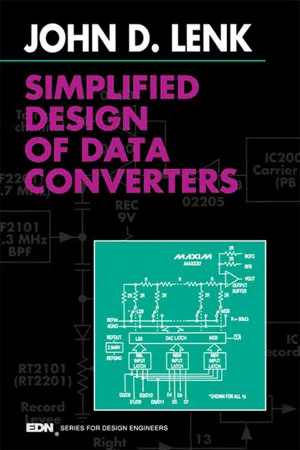
- 242 pages
- English
- ePUB (mobile friendly)
- Available on iOS & Android
Simplified Design of Data Converters
About This Book
Simplified Design of Data Converters shows how to design and experiment with data converters, both analog-to-digital and digital to analog. The design approach here is the same one used in all of John Lenk's best-selling books on simplified and practical design. Throughout the book, design problems start with guidelines for selecting all components on a trial-value basis, assuming a specific design goal and set of conditions. Then, using the guideline values in experimental circuits, the desired results are produced by varying the experimental component values, if needed.
If you are a working engineer responsible for designing data-converters circuits, or selecting IC data converters, the variety of circuit configurations described here should generally simplify your task. Not only does the book describe converter-circuit designs, but it also covers the most popular forms of data-converter ICs available. Throughout the book, you will find a wealth of information on data-converter ICs and related components.
- For all skill levels
- Tells how to design and build data-converter circuits from scratch
Frequently asked questions
Information
Data Converter Basics
1.1 Basic Data Conversion Techniques
1.1.1 Typical BCD Signal Formats Used in ADC/DAC Circuits

1.1.2 Four-Bit System in the Conversion Process
1.1.3 ADC Conversion Ladder
Table of contents
- Cover image
- Title page
- Table of Contents
- The EDN Series for Design Engineers
- Copyright
- Dedication
- Preface
- Acknowledgments
- Chapter 1: Data Converter Basics
- Chapter 2: Data-Converter Terms and Design Characteristics
- Chapter 3: Practical Design Considerations
- Chapter 4: Simplified Design with a Typical ADC
- Chapter 5: Simplified Design with a Flash ADC
- Chapter 6: Simplified Design with Serial-Interface DAC
- Chapter 7: Simplified Design with Parallel-Input DAC
- Chapter 8: Simplified Design Approaches
- Chapter 9: Low-Power Data-Acquisition System
- Chapter 10: Single-Chip Digital Multimeter
- For Further Information
- Index